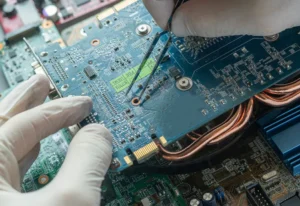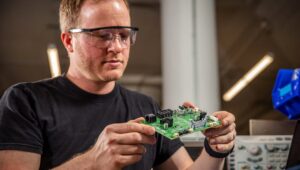When designing a PCB, we have to think through several issues
- Single-layer or double-layer board?
- Is it all inline or inline plus SMD?
- Does the factory support the red glue process?
Converted to a real problem, it is the mainstream design production solution
Choice one all-straight plug-in, single panel cost analysis: manual plug-in, one wave solder pass.
The earliest power supplies were designed this way. After all, at that time, wave soldering and reflow soldering were not really popular, and people were using the most traditional tin pots.
The full plug-in + single-sided paper PCB version is almost an epochal mark of a bygone era that is rarely used anymore.
Program two SMD + plug-in, SMD and plug-in a side cost analysis: first through a reflow, then through a wave soldering.
One reflow + one wave solder is actually standard on many companies’ production lines, so this solution is also the easiest way to design a power supply to be produced.
Program three SMD + plug-in, SMD on the bottom, plug-in on the top cost analysis: first do reflow soldering, welding SMD components; then make fixtures to cover the SMD components; and finally “visit” the plug-in, over the wave soldering.
The cost in this case is: wave soldering + reflow soldering + jig cost.
In the image is what is called a jig, where a special baffle plate is used to block the SMD components, leaving only the pins of the straight plug-in exposed, and then wave soldering is performed. But the prerequisite is that the SMD components are far enough away from the straight plug-in, and the cost of this jig is not low.
But in reality, because of the compact size required by modern power supplies, it is not possible to keep enough jig isolation space between the pins of the SMD components and the direct plug-in components. The common practice is to glue the SMD components to the reverse side of the board via red glue, then place the inserts, and finally unify them over wave soldering.
The cost in this case is: red glue cost + wave soldering.
The reason for doing this is because it’s cheap, but only if you have a red glue machine in your factory.
Program three is also the most common production solution for modern power supply manufacturing, but of course if the company does not have a red glue machine, then you have to choose program two, reflow once and wave solder once. The second option compared to the third option, because the SMD components and direct insert components are on a mounting surface, so it will take up a special PCB area, which also indirectly requires the power supply engineer’s ability to lay out the board.
PS: There is a more stingy approach to option 3, which is to make a single panel and leave everything else the same. The advantage is that you can save a little on the unit cost of the PCB, the disadvantage is that the wiring is much more difficult.
As you should have noticed, this board requires fly-by-wire. The flywire is actually a custom piece and not easy to plug in with the machine, so we recommend that you just use the double panel, which is not very expensive these days after all.
Program four two-sided patch + straight plug-in program four is definitely a dirt-cheap program ah, do not care about the cost of the design can be considered so produced.
Cost analysis: The cost of option 4 is mainly an additional heat reflow on top of option 3 or 2.
Cost analysis of Option 5 two-sided SMD solution: two reflow + price gain of SMD components.
This solution is used by very few people, and the reason is simple, because as mentioned before, the switching power supply inches away, SMD capacitors take up much more area than straight inserts, and they are not easy to buy.
The connection between the upper and lower board layers cannot be achieved using the over-hole of the plug-in pins, so many more over-hole will be created out of thin air. Of course such a solution has its benefits, namely high product reliability, as full patching is a means of production that has the opportunity to get rid of manual labor altogether.
Those are the five most common options for modern power supplies.
Program one, two, and three are all very common PCB design options these days, and the exact decision depends on coordination between you and the factory.
The base of the chip capacitor takes up a lot of space.















